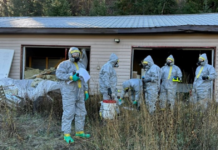Human trafficking in Canada often goes unpunished, new statistics show despite a troubling rise in cases.
On Monday, data published by Statistics Canada revealed that only a marginal portion of trafficking victims can see justice, as police only solve less than half of the cases.
Additionally, the majority of incidents that are reported to police do not end in charges being laid.
“Hearing those statistics, it’s enough to bring tears to my eyes,” Wyndolyn Brown, a trafficking survivor, told Global News.
The Statistics Canada report shows that the justice system appears to be stacked against survivors, as only 40% of the 4000 incidents reported between 2012 and 2022 resulted in police laying charges, or recommending charges.
“If [human traffickers are] not stopped, how many other girls do they traffic along the way?” asked Sarah Dillon, another survivor.
Almost all of the incidents were against women and girls, with 70% of the victims being under the age of 25, states the report and 25% were under the age of 18.
Of the incidents reported, 56% remain unsolved, however, some are still under investigation.
Over 3,500 charges were laid in a little over 1,000 cases, yet only 11% of the completed adult criminal cases resulted in a guilty verdict.
The majority of cases, 83%, resulted in charges being either stayed, withdrawn, dismissed or discharged.
“I had to go through the court system and see what it was like,” said Dillon, now 23, who said she was 18 when she was trafficked. “I went to a party and … I never came home. It was really just a couple horrific things happened to me at that party,” she said.
Dillon was trafficked for about a year before she managed to escape, however, she did return to her traffickers several times as a result of their coercion and manipulation.
Dillion believes that the low rate of traffickers being found guilty is because they are “are good at what they do ” and that police can often struggle to attain the necessary evidence.
“The sex trade — it’s all cash. There’s no paper trail,” she said.
Brown was first trafficked at the age of 15 for approximately one year, she is now 54-years-old.
“If I had to walk from where [her trafficker] had me to where my parents lived at that time, it probably would have [taken] me about 20 minutes,” said Brown.
“But because of the dynamics of what was happening and being always under the influence of some type of substance that he would give me and the control that he had over me, I couldn’t do that.”
According to the report, the average court case for trafficking takes almost 400 days from start to finish, about double the time that sex trade and other violent offence cases take.
“By (the time the trafficker is arrested), that man has already probably been back talking to you and trying to… put the manipulation back on your head,” said Brown. “And then we have another statistic… because now we’re going back and the cycle just completes itself over and over.”
Head of research and policy for the Canadian Center to End Human Trafficking James McLean said that Canada’s judicial system is heavily reliant on survivor’s testimony, which can be detrimental to a guilty decision.
“This has become a major obstacle when the survivor has experienced exploitative trauma and abuse and have to relive it through the court system for months or even years,” said McLean.
“We see that many survivors do choose not to go through the criminal justice system because it can be so intrusive, because it can be so time-intensive and because it can be re-traumatizing.”
During a trial, defence attorneys can often try to undermine the survivor’s credibility, questioning their character or the details of their memory.
“Survivors are often dealing with intense amounts of trauma and so they may misremember facts or they may remember things differently over the course of a trial,” said McLean.
“Some people may interpret that as lacking credibility, but it’s the way that a brain works when it’s been impacted by trauma.”
According to McLean, many victims are trafficked along Highway 401 from places like Windsor to Toronto, and then further up to Montreal.
“Highway 401 is a major corridor that traffickers use to move their victims to different sex markets,” he said. “(And) between Windsor and London and Toronto, up to Owen Sound, Ottawa and Montreal.”
Since 2021, the Canadian Center to End Human Trafficking has been making recommendations to the federal and provincial governments on how to identify the kinds of gaps in social policies that leave survivors more vulnerable to being trafficked, like providing them with proper housing and shelter.
The report does not include superior courts in Ontario, Manitoba and Saskatchewan or Quebec’s municipal courts.





















